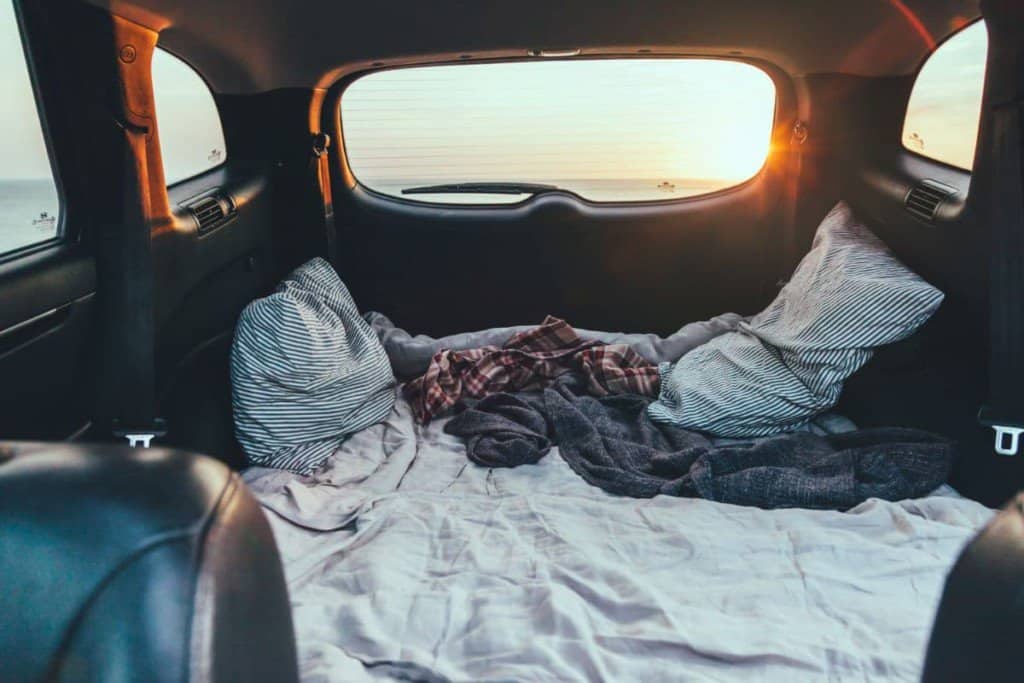Car camping involves camping in a vehicle without overt modifications like setting up a tent on a designated site. It’s an affordable and convenient camping option as it doesn’t require the purchase of elaborate camping equipment. Although relatively simple, there are some crucial safety tips you need to keep in mind when car camping.
To safely camp in your car, you need to park your vehicle facing an exit to ensure you’re ready to move in case a need arises. You should also try to stay alert throughout the night, carry enough food and water, pack warm bedding and share your location with friends.
This piece will explore seven safety tips to keep in mind when camping in your car.

1. Always Be Ready To Move
One massive advantage of camping in your car is you can make a hasty exit in your vehicle if there’s a safety threat. The preparation for this safety measure begins long before you arrive at the campsite.
There are many car camping locations in the United States, some safer than others. Therefore, research the best spots for car camping before you set off.
Read reviews to see people’s experiences at various campsites. Apps like iOverlander and The Dyrt show different campsites and provide information on the amenities and services available at each site.
You can also search the internet to find out if you need any special permits to camp at a particular location.
Once you find an ideal location for car camping, it’s best to arrive as early as possible. The best camping spots – those unobstructed spots with magical views and shade – get occupied first, hence the need to set out early enough.
To avoid losing out on a premium spot, get to the camping site before people start filing in. Arriving early allows you to park with the vehicle facing the exit, facilitating a hasty retreat in case things go awry.
If anyone parks ahead of you, ensure there’s enough space in front to maneuver around. Avoid sleeping with earplugs as they’ll detach you from the immediate environment and affect your ability to respond in the event of danger.
Furthermore, you should sleep with your car keys and glasses in close proximity to prevent unnecessary delays if the need to scamper to the driver’s seat arises. Finally, before parking, ensure your car has enough fuel or electrical charge to facilitate a quick getaway.
2. Share Your Location With Friends
Let people know your whereabouts, especially if you are traveling alone. You might be traveling in search of some alone time around nature, but for safety reasons, let someone know where you’ve camped!

You can share your location using the ‘Find My’ option present on most smartphones or give a friend your itinerary before you leave. If you rely on your phone to send your location, ensure it has enough charge throughout the trip.
Instead of using battery power to charge your electronics, purchase a portable solar panel kit to provide electrical power. For instance, this DOKIO 220W portable solar panel kit from Amazon.com is known for its impressive power retention ability and will charge your electrical devices throughout the trip.
Give your location to people you trust. Avoid giving your camping information to just anyone you meet during the trip. If you feel unsafe, provide a fake location to someone you suspect of sinister motives.
Car camping, though often a solo or couples activity, can be an excellent opportunity to meet people with mutual interests. Opt for a popular car camping spot to meet new people. Having people that you relate with around you increases your sense of security.
3. Carry Enough Food and Water
If the campsite you choose allows fires, you can cook and enjoy a hot meal as you watch the sun descend. However, I advise that you carry ready prepackaged food in a cooler to prevent it from going bad.
Water has multiple uses other than keeping you hydrated. You can use it to freshen up, wash fruits, and cook food. Furthermore, if your engine experiences cooling issues and you have no coolant available, you can use water as a coolant before you have the problem fixed.
4. Install Window Shades To Guarantee Privacy
It’s crucial to ensure air circulation inside the vehicle as you sleep. Leave a window or sunroof slightly open to let in air while preventing animals from getting in. All doors should remain closed as you sleep.
The small space left might not let in animals, but it will allow bugs to infiltrate your sleeping area, leading to an uncomfortable night. Installing window shades will solve this problem while providing you with much-desired privacy.
Most window shades have a mesh construction that allows air but prevents light from passing through. Window shades solve two problems: they prevent bugs from entering your vehicle and people from seeing inside.
If you prefer to use roof top tents, it’s best to mount the structures well for enhanced comfort. Check out this article for roof top tent mounting ideas you can use to make your experience worthwhile.
5. Carry Warm Bedding
The inside of a vehicle can get cold during the night, especially when camping in areas with freezing temperatures. Therefore, ensure you have enough warm blankets and duvets to prevent any health complications brought about by the cold.
Your car’s floor is a handy place to sleep, but it can be uncomfortable. To avoid waking up with a sore back or neck, invest in sleeping bags, an air mattress, or a foam mattress.
Park your car on a flat area and sleep with your head towards the front where there’s more room.
6. Carry a Portable Jump Starter
Before you set off in your car, ensure it’s properly serviced and everything is in prime working condition. You don’t want your car breaking down during your journey, as besides being an inconvenience, it’s also a huge safety risk.
An issue that might arise during car camping is a dead car battery. It’s easy to forget to unplug something from the cigarette lighter, draining your battery during the night.
You can restart your car without anyone’s help with a portable jump starter. This piece of kit is essential when traveling to a remote location.
7. Carry Portable Lighting
While camping, it’s best to rely on your car’s battery power as little as possible. Instead of using the car’s internal lights to illuminate your camping area, use portable lighting.
You can also use the lights outside if the camping area doesn’t allow fires. If the batteries run out, recharge them using the portable solar panel.
Conclusion and Recommended Articles
While car camping is generally safe, taking these extra steps will ensure you have a safe and fun adventure! I would also like to add that if you’re looking to take your car camping experience to the next level, take a look at some of these roof top tents.
Another possible way for overlanding is tent camping. But which one is better? Car camping or tent camping? Here is my full guide comparing each respective type of camping!
